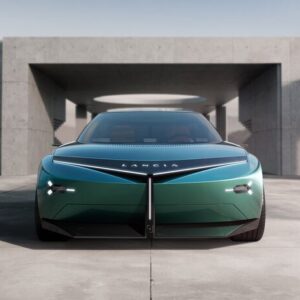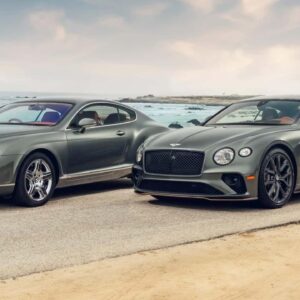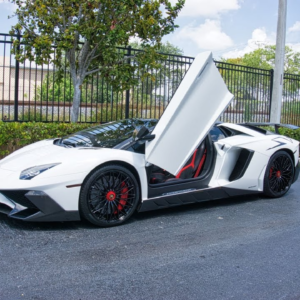“Bring it on,” the smiling Aston Martin PR man said to the then 31-year-old Mate Rimac, then CEO of just Rimac, now CEO of Bugatti Rimac. In early March of 2019 I found myself seated below them inside the Valkyrie prototype on the Aston stand at that year’s Geneva Motor Show. Aston Martin’s then CEO, Andy Palmer, said I could sit in the second most outrageous show car I’d ever laid my eyes on, and the poor Aston PR man had to smile and make it happen. Back then, MotorTrend’s World’s Greatest Drag Race was still a thing, and there was no global pandemic. I’d asked if we could have a Valkyrie for the 2021 edition of our video, as back then it seemed as if Valkyrie was but two years away. Mr. Rimac countered that we could use one of his 1,887-hp EVs, implying that it would beat the upcoming English hypercar. “Doesn’t matter,” the man from Aston said. “Valkyrie will win.”
Three years and 11 months later I find myself standing in the pits of the Bahrain International Circuit, the small island kingdom’s F1 track, staring lustfully at the production Valkyrie. And I’m about to drive it. I knew the deal going in—52 hours of travel for six laps—and I didn’t care. Especially as I wound up doing eight. Two different Aston Martin CEOs (Palmer, and the recently departed Tobias Moers) both promised me I could drive the Valkyrie, and the same long-suffering PR man made good on those promises. Despite the nearly four-year wait, I still get goosebumps looking at the Valkyrie. How can it be a real car? It’s just so outrageous. Seemingly every one of the dozen-ish Aston people I spoke with throughout the day kept saying, “How can it have number plates?” Number plate is British for license plate, and it’s a fantastic question, one that after driving the thing I still can’t comprehend.
How The Sausage Is Made
Let me recap some Valkyrie basics for you: The car was famously conceived over four plates of bangers and mash eaten by F1 design legend Adrian Newey, Red Bull team principal Christian Horner, Aston CEO Andy Palmer, and Simon Sproule, the then head of Aston’s marketing and communications. Newey had long wanted to develop “the ultimate road car,” and Horner desperately wanted to keep him away from Ferrari and at Red Bull. After who’s to say exactly how many “tepid lagers,” the foursome agreed to build the Valkyrie. Newey would basically have final signoff on everything, it would be very expensive, weigh as little as possible, use every one of Newey’s best tricks, and make well over 1,000 horsepower from a naturally aspirated V-12 combined with an electric motor. Also, the initial plan was to only build 15, then 24, then 59 street versions.

Well friends, here’s where the Valkyrie wound up. The price is essentially $3,000,000 per car (before any customization), and the 150 coupes, 40 track-only AMR Pros, and 85 Spiders (convertibles) have all been sold. Aston is claiming a dry weight of 2,800 pounds, which would put it at a bit over 3,000 pounds with a fluids. The Cosworth 6.5-liter V-12 screams to 11,100 rpm and makes 1,001 horsepower (more than the original Bugatti Veyron’s quad-turbo 8.0-liter W-16 made—987 hp) and 575 lb-ft of torque, while the hybrid e-motor adds in another 141 hp and 207 lb-ft of twisting force. The combined peak output is staggering, if not jaw-dropping: 1,139 hp at 10,600 rpm and 682 lb-ft of torque at 7,000 rpm. As for downforce, to my mind the numbers are comical: 2,425 pounds of downward pressure from 137 to 220 mph, the Valkyrie’s top speed. That’s nearly 1,000 pounds more than an F1 car generates! Fun fact: The Valkyrie is capable of generating up to two tons of downforce, but the standard tires start popping over 2,500 pounds. No, really.
Say What?
To call the Valkyrie an engineering marvel would be to undersell what Aston Martin has accomplished. As I was told, “The Valkyrie sets its own benchmark.” Some quick examples of why that is. The seats weigh less than the doors. The doors weigh less than the wheels. The wheels weigh less than the tires. The air vents are sculpted into the carbon-fiber tub; the carbon-fiber dashboard serves as the top of the vents. The inboard, electronically activated hydraulic torsion-bar suspension was banned by F1. The single windshield wiper A) is a torsion bar, as it literally twists around the canopy windshield; B) took one full year to engineer; and C) is built and supplied by the same company that built the wipers for the Space Shuttle. The Valkyrie sports the world’s smallest center brake light; the same is true of the license plate lights. So much titanium was used by the program that Britain’s Ministry of Defense contacted Aston to inquire what it was up to, as purchase orders for the Valkyrie had spiked global prices. The last time this happened was when the CIA and the Air Force built the SR-71 Blackbird. Do you get the idea?

Please Shut Up And Drive
Before I left, our executive editor, Mac Morrison, reached out to say, “This story is obviously one that lends itself to ‘Oh my god, holy [expletive], this thing is unhinged…’ but we don’t want it to just be that.” I told him yes, absolutely, that makes total sense, all the while planning on writing exactly what Mac told me not to. I’m a large child. But as is (almost) always the case, reality has a funny way of hucking spanners into the works. The Valkyrie is extreme. Full stop, end of story. It’s extreme. I’ve been trying to think of another way to phrase this, but Aston has succeeded in building the most extreme vehicle I’ve ever driven. By miles. Keep in mind, I’ve driven some whackadoodle stuff. Aston Martin has long said the Valkyrie is intended to be an F1 car for the road. Although I’ve never driven an F1 car, and meaning no offense to AMG, this uncompromising download of Newey’s brain must be, has to be, as close to a road-legal F1 car as can ever exist. But to re-underline it, the Valkyrie is extreme, and I mean that in every possible way.
It’s deafening inside. I wore a helmet for the eight fast laps, and helmets act as ear plugs. I drove one fake lap at stuck-in-traffic speeds for the camera and wore the included (and effective) noise-canceling headphones. At one point, just for fun, I pulled the headphones off. Deaf-En-Ing. And not a particularly nice noise, either, which was weird considering how damn sexy the Valkyrie sounds blasting past. It’s similar, if not better than an actual F1 car from the early ’90s V-12 era. I should point out that I was lugging the V-12 around at maybe 4,000 rpm. Imagine the noise at full boogie! Why so loud and so uneasy on the ears? The V-12 is a fully stressed member of the chassis, screwed to the structure with four imperial bolts (Newey insisted on imperial bolts as these are a gram or two lighter than the metric equivalents). Therefore, there are no NVH-swallowing engine mounts. What about sound deadening? None. Keep in mind, Newey forced Cosworth to remove the clearcoat off the carbon-fiber intake plenum because all that gloss weighed 80 grams.
I’m big, but not that big, and I struggled inside the Valkyrie. True, I was too fat to fit inside the fire suits Aston brought to Bahrain (the largest size they brought was a 56 and if I were 25 pounds lighter, I’d need a 60), but I had three ergonomic issues on the track. The first is that the pedal box is tight, especially if you have large feet. I’d recommend tight-fitting racing boots. Get comfortable with the idea of left-foot braking, as there’s not much room for your left foot to be anywhere but over the brake pedal. Remember, you’re effectively sitting in a tube, and your heels are higher up than your butt. Second was that my helmeted head kept smacking against the roof (which is the door—gullwings). Aston designer Miles Nurnberger—who stands about 6-foot-2—tells me that he and Marek Reichman, Aston’s 6-foot-5 chief creative officer, were the design bucks for Valkyrie’s interior. Technically, I’m sure they both fit. However, after my laps I blurted out, “I’d like to see Marek in a helmet fit in here.” That crack was met with knowing nods and laughter.
But tight pedals and smacking a helmet on a roof are woes that affect other cars. I had a unique issue in Valkyrie: The back of my knuckles kept getting stopped by my thighs in tight corners. Thankfully, the car’s steering is quick to the point you rarely go past 45 degrees of input on a normal turn. However, the Bahrain Circuit has three ultra-tight, first-gear corners and four tight enough to be second-gear corners. I had to remove a hand from the wheel multiple times per lap. Disconcerting to say the least in such a powerful, expensive beast. Moreover, I noticed that in the track-only Valkyrie AMR Pro variant I got some wild hot laps in, the steering wheel is mounted much higher up off the driver’s lap. Meaning test engineers noticed this was an issue.

Did You Like Anything?
Yes. A great deal. If I may quote Morrison again, “Oh my god, holy [expletive], this thing is unhinged!” The power, while extreme, is the stuff car dreams are made of. I have no idea how all that power and fury spinning just two wheels even works, but grip under straight-line acceleration is impressive to the point that the Valkyrie feels AWD. It’s not—the electric motor sits between the engine and the Ricardo seven-speed sequential transmission—but the thing is just planted under power, even the few times I hit the ERS button (Energy Recovery System, similar to KERS in F1). The nearly unimaginable thrill of pulling a shift paddle at over 11,000 rpm is a career moment for me. Every gear change felt like cheating death. To do so multiple times down the 4,000-foot-long straight is the reason I started doing this nonsense for a living.
But this is the Valkyrie and nothing is easy. You may be aware that Aston has had some issues in delivering fully baked Valkyries to customers. Electrical gremlins have plagued the complex project, and as one engineer explained to me, there are 15,817 adjustable parameters on Valkyrie. Not permutations, but literally 15,817 individual levers that the computer can pull at any given moment. Crikey. Not sure if the following is related to the above, but the car I drove struggled with the heat on the pavement. It was a warmish day (high 80s) but (according to Aston) because the car runs so low in Track mode, the heat from the asphalt was affecting cooling. The Valkyrie kept lowering its redline, first capping it at 10,000 rpm, then dropping it to 9,000 rpm, effectively pulling power. I spoke with another journo who drove it on a cooler day, and there were no such issues.
Newey’s overkill aerodynamics come alive above 100 kph (62 mph), and if I may channel Tom McCahill for a moment, it handles like a snake in a drainpipe. Seriously, at speed the Valkyrie is stuck like hot gum to black asphalt. However, below 62 mph when the aero isn’t doing much, the Michelin Cup 2s aren’t up to the task. Remember all those tight corners I mentioned earlier? You’re moving well under 62 mph in most of them, and I managed to inadvertently drift the Valkyrie a few times. The rear kept stepping out on me. While fun and easy to correct, it’s an odd feeling to experience in a $3 million car. I should point out that this only started happening after I’d taken the traction control out of Sport and into Track, and then started dialing the TC down each lap beginning at 6 all the way down to 3 (it’s adjustable from 10 to 0, and 0 is off).
Before he departed Aston, Moers told me about testing the Valkyrie. Smiling, he said something to the effect of, “You won’t believe the engine at 11,100 rpm.” Quickly followed by, “Lucky for our customers, we have very good traction control.” My point: The Valkyrie is a race car, one that’s sadly tire-limited. Why? Because development started long enough ago that Cup 2 R tires were just a twinkle in Michelin’s eye. I recommend springing for the AMR Track Performance Pack that comes with stickier Cup 2 R tires. Said pack also adds another 1,760 pounds of downforce, for a ludicrous total of 4,180 pounds. Think that’s absurd? The Valkyrie AMR Pro produces 5,940 pounds of downforce! Back to the stock tires, could you just put the street car on the AMR Pro’s fat slicks for track days? Apparently, they won’t fit.

The Conclusion: A Singular Experience
The Valkyrie is extreme. Not to put too fine a point on it, but it’s a barely disguised race car. The halfshafts go through the A-arms, for the love of taking things too far. I didn’t get the chance to drive it anywhere other than on a perfectly smooth F1 track, but it felt like every single Aston employee on hand assured me it’s surprisingly easy to drive on the street. Which leads the cynic in me to think that surely it must be awful. Also, having to cinch yourself into five-point belts and strap on headphones to grab coffee? No thanks. Well, 1,139 horsepower to get to a bagel does sound appealing. Again, extreme.
A friend of mine used to own a Lamborghini Countach and he told me not only did his wife refuse to be seen in it, but he preferred eating his Cheerios sitting cross-legged in front of it and admiring its shape to driving it. See, the Countach isn’t all that great from behind the wheel. I would know. It’s still my favorite car, I’m just on the same page with reality. I said up top that the Valkyrie is the “second most outrageous show car” I’ve ever seen. The first was the Vector W8, a stealth fighter of thing I saw for the first time in 1989 that still gives me chills. Never driven a Vector, but I’m assured by people who have that they’re terrible.
The Valkyrie isn’t terrible—far from it—but for whatever reason it’s not what I was expecting. Frankly, I’m struggling to imagine what owners are going to do with them. The thing is mental. It’s unhinged. It’s nerve-wracking. It’s as close to an F1 car as I’ll likely ever get. It’s extreme in the extreme. The issue is, after solving every problem inherent in Newey’s initial back of the menu sketch, Aston neglected to make the Valkyrie fun. There, I said it—I was expecting the car to be more fun. Then again, the Valkyrie does deliver on every other front. Would I have one, had I the money? In a heartbeat. Not everything has to be fun, kids. Also, I guarantee the notion of “fun to drive” never crossed Newey’s mind, not even once. Also, the astonishing, near-ethereal acceleration is in fact damn fun. Point is, sometimes being as serious as a heart attack is exactly the point. Other times, laying eyes on one of the absolute greatest-looking cars the world has ever seen is all it takes. Combine those two elements, and you’ve got the Aston Martin Valkyrie. As extreme and uncompromised as the automobile is likely to get.































